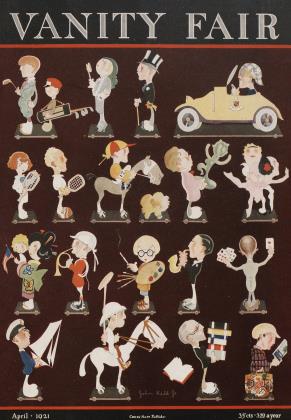Sign In to Your Account
Subscribers have complete access to the archive.
Sign In Not a Subscriber?Join NowMotoring Facts and Figures
Some Interesting Spots in a Hectic Period in the Motor World
GEORGE W. SUTTON, Jr.
AS a rule, statistics are dull things. However, it is by statistics that we judge human progress in the final analysis, rather than by the accomplishments of the individual.
Let us. assume, therefore, that the man who owns and operates an automobile is interested in the great facts which contribute to his possession of his Pierce-Arrow or Buick or Ford or any other motor unit of transportation. If he could visualize the enormous figures which have contributed to his ownership of that particular car, he would realize instantly the relation the automobile bears to our modern life and the changed relation he bears, as a motorist, to the rest of humanity.
When we learn, for instance, that 1,906,000 passenger cars were built in the United States during 1920, it means little at first. We forget the existence of all these and the other 7,000,000 cars in the country and think only of the vagaries and whims of our own particular car, whereas the thought worth thinking, when we see these totals, is that approximately 9,000,000 of our people have come into possession of personal, individual transportation and that 1,906,000 of them have transportation which is a little better, a little more elegant, and a little more efficient than the others. In other words, it means that an ever-increasing percentage of our population is reaching its objectives of convenience, business, recreation and amusement by use of motor cars more quickly, more easily and in better frame of mind than is made possible by any other known means of conveyance.
N CONSIDERING the figures recently announced by the National Automobile Chamber of Commerce for the year 1920, we note with mild interest that 335,000 trucks were manufactured. This becomes important only when we learn that these trucks, together with those which were manufaclured in other years, carried almost half of the freight in the country, transporting 1,200,000,000 tons, against 2,504,000,000 tons for the railroads, 4,000,000 for the interurban trolleys and 90,000,000 tons which went over the Mississippi and the Great Lakes.
Continued on page 82
Continued from page 68
Some people continue to look upon the automobile as a luxury. To balance against the utilitarian accomplishments of the motor car we have the fact that the average wholesale price paid for passenger cars last year was $897, a truly small cost for the service the motor car performs. The figures for 1920 reveal further that we made 32,400,000 tires, of which we exported 27,000, and that of our passenger cars 153,000 went abroad.
Last summer two conditions arose which were of vital interest to motorists. One of these was the congestion of the railroads and the other was the restriction of banking credits. In the automobile world the railroad situation caused the industry to deliver cars directly from factory to the buyer, under' their own power. More than 470,000 automobiles were driven over the roads during the period by dealers who could not secure freight car space.
Banking conditions caused a cessation of car buying, especially by those people who wished to purchase on instalments. This caused a cut in the production plans of the various companies, and it may be interesting to our readers to look over the following partial list, as compiled by Automotive Industries Magazine:
1920 1920 Produc- EstiCar tion mate Briscoe . 6,065 30,000 Buick . 111,255 200,000 Cadillac . 20,549 25,000 Chalmers . 9,772 15,000 Chevrolet . 126,172 120,000 Columbia . 4,806 8,000 Dodge . ... 141,256 200,000 Dort . .... 23,853 30,000 Essex . ... 26,002 40,000 *Ford . .. ..1.023,552 1.000,000 Handley-Knight 115 Hudson . ... 21,357 30,000 Hupp . .... 19,220 24,000 Jackson . 1,347 6,500 King . 2,081 10,500 Liberty . 4.414 15,000 Lincoln . 285 6,000 Lorraine . 300 4,000 Maxwell . ... 34,168 80,000 Nelson . 615 4,000 Oakland . .... 36,264 100,000 Oldsmobile .... ... 25,7S6 80,000 Overland . ... 97,446 200,000 Packard . 6,040 10,000 Paige . ... 16,722 30,000 Patterson . 1,071 3,000 Reo . ... 14,839 22,000 Roamer . 1,657 4,000 Saxon . 739 10,000 Scripps-Booth . 9,288 20,000 Studebaker .... .... 52,000 80,000 Willys-Knight . .... 15,813 80,000 Total. . .. 1,848,049 2,487.000 *Of the total 153,532 were trucks.
Recently I had the pleasure of riding in two Rolls-Royce chassis at the Springfield factory—one, the first completed in this country; the other, a brand new machine just over from England. They were identical in appearance; their operation was equally smooth and marvellously flexible. I tried to guess which was the American car and apparently failed, because my opinion was based solely on a 'hunch'. This international experiment is extremely interesting to watch. Anybody, engineer or layman, who rides in the domestic Rolls and has had the idea that it could not be built successfully in this country is in for a revelation.
 View Full Issue
View Full Issue












Subscribers have complete access to the archive.
Sign In Not a Subscriber?Join Now